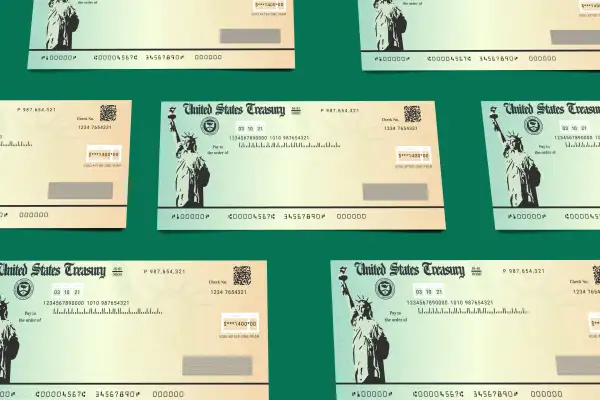$1,400 Checks and More: 6 Ways You May Benefit From the New Stimulus Package

President Joe Biden signed the $1.9 trillion relief package into law Thursday, helping millions of Americans still struggling financially as the nation races to end the year-long pandemic that has hobbled the global economy. And while you might have heard the most buzz around its $1,400 stimulus checks, the American Rescue Plan, which cleared its last hurdle in Congress Wednesday, actually includes several provisions that could benefit your finances.
We combed through the wide-ranging law's more than 600 pages so you don’t have to. From expanded unemployment benefits to lower health insurance costs, here are the six biggest ways the plan may affect your wallet.
You could get a third stimulus check
The package provides for a third round of stimulus checks, formally called Economic Impact Payments, in the amount of $1,400 per person (or $2,800 per married couple filing jointly).
The IRS will calculate the stimulus amounts based off of people's 2019 — or, if they've already filed, their 2020 — tax returns. The checks are tied to adjusted gross income, which is your income after deductions like retirement plan contributions. Single filers who earn $75,000 or less and couples earning $150,000 or less qualify for the full payments. Over those income thresholds, the amount decreases, zeroing out at $80,000 ($160,000 for couples).
Americans who qualify will also receive $1,400 per dependent, a category that includes not only children but also college students and adult dependents. This is a departure from the previous stimulus payments, which left out dependents age 17 and over.
These $1,400 payments, combined with the $600 checks distributed in January, are meant to reach the $2,000 sum promised by the Biden administration. They come about a year after the CARES Act first approved $1,200 payments to help people through the pandemic last spring.
As far as the timeline for the third stimulus check, White House Press Secretary Jen Psaki said Monday that Treasury Secretary Janet Yellen is "focused like a laser" on making sure the aid "gets out as quickly as possible."
Judging from previous EIPs, direct deposits could drop within a matter of days, so keep an eye on your bank account. If the IRS doesn’t have your information on file, it’ll snail-mail you a paper check or prepaid debit card.
Your unemployment benefits will be extended
The latest stimulus package will also provide some relief to the millions of people still unemployed, and not a moment too soon. Extended unemployment benefits from the last relief bill are set to expire on March 14.
The plan extends the $300 weekly enhanced unemployment benefits included in the last relief package until Sept. 6. It also extends the two temporary unemployment benefit programs — the Pandemic Unemployment Assistance (PUA) and Pandemic Emergency Unemployment Compensation benefits (PEUC) — through Sept. 6. The PUA covers those who don’t qualify for traditional benefits, like freelancers, gig workers and self-employed business owners, while PEUC extends benefits for those who have exhausted their state benefits.
The American Rescue Plan also includes a tax break on unemployment benefits. Individual taxpayers with incomes of less than $150,000 in 2020 won’t need to pay federal taxes on the first $10,200 of unemployment benefits they received last year. For married couples in which both spouses collected unemployment benefits and their combined income is less than $150,000, experts say federal income taxes could be waived for up to $20,400 of benefits.
Waiving these taxes could save millions from surprise tax bills during an already difficult time. Taxpayers can choose to withhold 10% of unemployment benefits to cover some or all of their tax liability, but fewer than 40% of unemployment insurance payments in 2020 had taxes withheld, according to a research paper published last month by The Century Foundation.
Your family might receive a bigger Child Tax Credit
The plan includes major (although temporary) enhancements to the Child Tax Credit, making benefits more generous for tens of millions of families.
First, the bill increases this year’s benefit from $2,000 per child to $3,600 for children under the age of six and $3,000 for all other children, including dependent 17-year-olds, who had previously been ineligible. According to a report from the Center on Budget Policy and Priorities, the increase is expected to reduce childhood poverty by 40% this year.
The tax credit, which is usually non-refundable, will be made fully refundable for the year 2021, meaning families can claim the full benefit even if it’s more than the amount of income tax they owe. The bill also removes the $2,500 income requirement that previously kept the poorest of parents from receiving the help in the first place.
In order to get the tax credit into the hands of more people as quickly as possible, the bill authorizes the IRS to send out monthly payments between July and December 2021 to families who opt in, instead of waiting for them to file taxes next year. However, questions still remain on whether or not the IRS will be able to accommodate such a major system overhaul in such a short period of time.
Finally, in order to target the larger payments to lower- and middle-income households, the income threshold for the benefit phase-out has been drastically reduced. Under the new provisions, the enhanced credit will begin to phase out at $75,000 for single returns, $112,000 for head-of-household returns, and $150,000 for joint returns, a steep reduction from $200,000 for single and head-of-household and $400,000 for joint filers in previous years.
You’ll avoid a big tax bill if you have student debt forgiven
Democratic Senators slipped in a small but potentially major amendment to the bill that ensures any student loan borrowers who have debts forgiven through a one-time cancellation or through existing programs won’t get hit with a big tax bill in the next five years.
The change applies to existing debt cancellation available through the government’s income-driven repayment plans, which set monthly payments based on your earnings and offer forgiveness after a minimum of 20 years. But crucially, it also applies to any widespread debt cancellation that may come from the Biden administration.
The tax-free status covers any cancellation that happens between Jan. 1, 2021 and the end of 2025. Without the change, a borrower who had, say, $50,000 wiped out by the government would owe roughly a quarter of it back in taxes.
Debt forgiveness via the Public Service Loan Forgiveness program, which is offered to professionals like teachers and non-profit employees, is already exempt from taxes. So is any cancellation for students who were defrauded by their college. But the tax liability of future loan forgiveness from other programs has been a major, looming issue, according to borrower advocates, because of the increasing popularity of income-driven repayment plans.
Still, because this change is temporary, it appears targeted toward a one-time, large-scale cancellation — as many progressives are pushing Biden to do — rather than a permanent solution. If you’re one of the 8 million borrowers enrolled in an income-driven repayment plan, and for example, you’re expecting your remaining balance to be canceled in 2035, this doesn’t help you.
Your Obamacare policy will become more affordable
The new law will lower health insurance costs for millions of Americans who buy individual or family policies through the Affordable Care Act, also known as “Obamacare.” It will temporarily cap premium costs at 8.5% of income for all consumers, including those whose incomes fall above the threshold for government premium subsidies.
This means that consumers making more than 400% of the federal poverty level — or $51,520 for an individual in 2021 — will see their premium costs contained for the first time since the law’s inception. Having to pay the full cost of coverage often put health insurance out of reach, even for more affluent households. Those with lower incomes who currently qualify for subsidies will receive even more assistance under the American Rescue Plan, lowering their premium costs further.
Older Americans pay the highest premium costs, so they will see the biggest savings under the bill. A 64-year-old with an income of $58,00 would save nearly $8,000 annually on premium costs, according to a Health Affairs analysis of Congressional Budget Office projections.
There’s a special Obamacare open enrollment period underway through May 15, so consumers can sign up for health insurance right away. The provision to cap premium costs at 8.5% of income applies to benchmark, silver-tier plans and expires at the end of 2022. That year, the Congressional Budget Office expects that expanded premium subsidies will encourage an additional 1.7 million to enroll in marketplace coverage, most of whom are currently uninsured, Health Affairs reported.
What’s more, under the new law the government will subsidize the cost of COBRA coverage through the end of September, so those who leave their jobs or are laid off don’t need to pay full price to continue their employer-sponsored coverage through that time.
You could get help paying your housing bills
At the end of last year, 8.8 million renters and 2 million homeowners were “significantly” behind on their housing payments, according to the Consumer Financial Protection Bureau. To directly help these struggling tenants and homeowners, lawmakers have included over $40 billion in housing assistance in the new law.
Provisions include $20 billion in emergency rental assistance, a $10 billion homeowner assistance fund and $5 billion to cover energy and water costs. Experts view rental assistance as particularly important in helping to reduce poverty.
Households can now receive up to 18 months of rental assistance. The relief can be applied to back or future rent or utility costs.
To qualify, tenants must have also qualified for unemployment benefits, have a household income below 80% of area median and be at risk of homelessness or housing instability. How much a household can receive depends upon where they live and their housing costs, which must be verified by a lease or other documentation.
Notably absent from the bill, however, are further extensions to federal eviction moratoriums. The Biden administration previously sought to use the law to extend both eviction and foreclosure bans until the end of September, according to a White House fact sheet.
Last month, the Department of Housing and Urban Development, Department of Veterans Affairs, and Department of Agriculture did extend foreclosure moratoriums until June 30. The departments, which all back or buy mortgages, also expanded the window of time to apply for mortgage forbearance and added six months of forbearance eligibility. Some say a longer pause is necessary to keep people in their homes and prevent the spread of coronavirus. Officials have said further extensions are still possible.
This story has been updated to reflect that President Joe Biden signed the American Rescue Plan into law Thursday.
More from Money:
The New Investor's Survival Guide: How to Make Money (and Stay Sane!) in Today's Wild Markets





